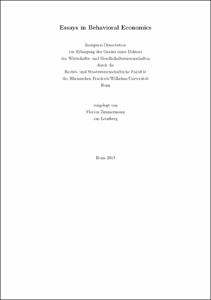Zimmermann, Florian: Essays in Behavioral Economics. - Bonn, 2013. - Dissertation, Rheinische Friedrich-Wilhelms-Universität Bonn.
Online-Ausgabe in bonndoc: https://nbn-resolving.org/urn:nbn:de:hbz:5-32853
Online-Ausgabe in bonndoc: https://nbn-resolving.org/urn:nbn:de:hbz:5-32853
@phdthesis{handle:20.500.11811/5436,
urn: https://nbn-resolving.org/urn:nbn:de:hbz:5-32853,
author = {{Florian Zimmermann}},
title = {Essays in Behavioral Economics},
school = {Rheinische Friedrich-Wilhelms-Universität Bonn},
year = 2013,
month = jul,
note = {Chapter 1 focuses on individuals’ attitudes towards the timing of information. We test a theoretical prediction by Kőszegi and Rabin (2009), that people prefer to get information “clumped together” rather than piecewise. We conduct a controlled lab experiment where subjects participate in a lottery and can choose between different resolutions of uncertainty (clumped or piecewise). In two treatments we analyze which kind of resolution is preferred. Two additional treatments allow us to get a quantitative measure of subjects’ preferences over different information structures. Our data does not support the prediction that piecewise information is utility-decreasing.
In chapter 2, we ask if reports of private information about skills, abilities or achievements are affected by image concerns. We develop a simple model that illustrates how image utility can lead to misreporting of private information in contexts where truthful reports maximize monetary outcomes. In addition, we test the model’s predictions in a controlled lab experiment. In the experiment, all subjects go through a series of quiz questions and subsequently report a performance measure. We vary if reports are made to an audience or not and find evidence for image effects. In the audience treatment, stated reports are significantly higher than in the private treatment. This suggests that overconfident appearance might be a consequence of social approval seeking. We also find that men state higher self-assessments than women. This gender difference seems to be driven by men responding more strongly to the presence of an audience.
Chapter 3 studies the role of consistency as a signaling device. We propose a two- period model that highlights the informativeness of consistency as a signal of skills and allows to analyze consequences for behavior. In a simple principal-agent experiment we test the basic intuition of the model, that consistency is valued by others, inducing people to act consistently. In the second part of the chapter we study the consequence of early commitment for behavior. In the context of an estimation task we demonstrate that commitment leads to a neglect of valuable information. Furthermore, the potential of consistency as a device of social influence is studied in the context of surveys.
In Chapter 4, we provide an explanation for so-called anchoring effects. Random anchors have been shown to systematically affect judgments and valuations. This has called into question the rationality of judgments as well as the existence of stable preference relations. Instead this evidence suggests that both judgments and valuations are to a large degree arbitrary. This chapter is an attempt to reconcile evidence from anchoring manipulations with a model where decision-makers are rational and have stable preferences or judgments.},
url = {https://hdl.handle.net/20.500.11811/5436}
}
urn: https://nbn-resolving.org/urn:nbn:de:hbz:5-32853,
author = {{Florian Zimmermann}},
title = {Essays in Behavioral Economics},
school = {Rheinische Friedrich-Wilhelms-Universität Bonn},
year = 2013,
month = jul,
note = {Chapter 1 focuses on individuals’ attitudes towards the timing of information. We test a theoretical prediction by Kőszegi and Rabin (2009), that people prefer to get information “clumped together” rather than piecewise. We conduct a controlled lab experiment where subjects participate in a lottery and can choose between different resolutions of uncertainty (clumped or piecewise). In two treatments we analyze which kind of resolution is preferred. Two additional treatments allow us to get a quantitative measure of subjects’ preferences over different information structures. Our data does not support the prediction that piecewise information is utility-decreasing.
In chapter 2, we ask if reports of private information about skills, abilities or achievements are affected by image concerns. We develop a simple model that illustrates how image utility can lead to misreporting of private information in contexts where truthful reports maximize monetary outcomes. In addition, we test the model’s predictions in a controlled lab experiment. In the experiment, all subjects go through a series of quiz questions and subsequently report a performance measure. We vary if reports are made to an audience or not and find evidence for image effects. In the audience treatment, stated reports are significantly higher than in the private treatment. This suggests that overconfident appearance might be a consequence of social approval seeking. We also find that men state higher self-assessments than women. This gender difference seems to be driven by men responding more strongly to the presence of an audience.
Chapter 3 studies the role of consistency as a signaling device. We propose a two- period model that highlights the informativeness of consistency as a signal of skills and allows to analyze consequences for behavior. In a simple principal-agent experiment we test the basic intuition of the model, that consistency is valued by others, inducing people to act consistently. In the second part of the chapter we study the consequence of early commitment for behavior. In the context of an estimation task we demonstrate that commitment leads to a neglect of valuable information. Furthermore, the potential of consistency as a device of social influence is studied in the context of surveys.
In Chapter 4, we provide an explanation for so-called anchoring effects. Random anchors have been shown to systematically affect judgments and valuations. This has called into question the rationality of judgments as well as the existence of stable preference relations. Instead this evidence suggests that both judgments and valuations are to a large degree arbitrary. This chapter is an attempt to reconcile evidence from anchoring manipulations with a model where decision-makers are rational and have stable preferences or judgments.},
url = {https://hdl.handle.net/20.500.11811/5436}
}






